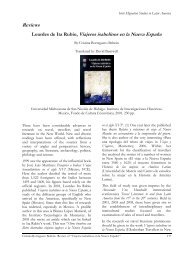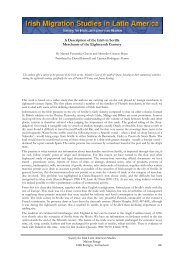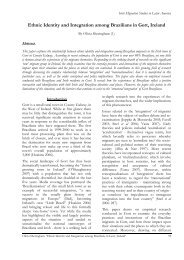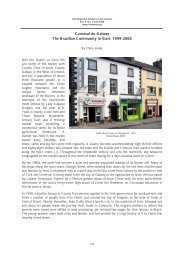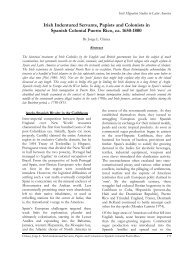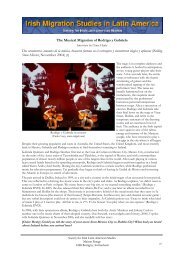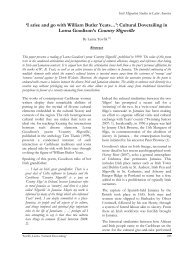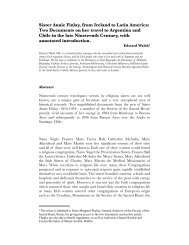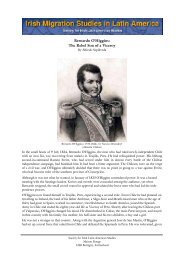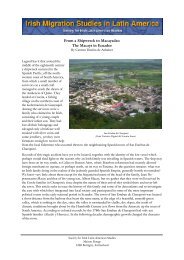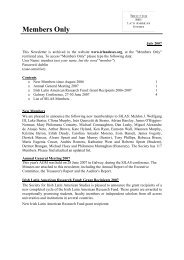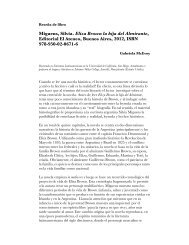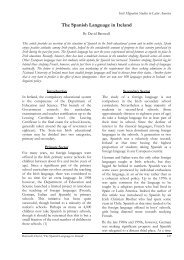I:6 Anti-dumping - Society for Irish Latin American Studies
I:6 Anti-dumping - Society for Irish Latin American Studies
I:6 Anti-dumping - Society for Irish Latin American Studies
You also want an ePaper? Increase the reach of your titles
YUMPU automatically turns print PDFs into web optimized ePapers that Google loves.
author posed that mothers had a superior and noble mission in life. “The home is the initial and the<br />
greatest primary school [...] [where the] principles of honour and virtue are instilled”. [86]<br />
These two visions, expressed by men, describe the archetypical housewife and mother. However, we must<br />
remember that many <strong>Irish</strong>-Argentine families were true matriarchies. Women worked side by side with<br />
their husbands. When the men were away on a journey, or passed away, women were unafraid of taking<br />
command. They administered their properties, and they raised their children with discipline, preparing<br />
them <strong>for</strong> life’s struggles.<br />
When it came to <strong>for</strong>mal education, girls and boys had the same rights. As a matter of fact, Father Fahy,<br />
solved the matter of the girls’ education first, sending <strong>for</strong> the Sisters of Mercy. It should also be noted that,<br />
at the time when the two articles we just quoted were printed, the schools run by the Sisters offered<br />
commercial courses that allowed their students to become secretaries in multinational corporations and<br />
earn their living.<br />
Conclusion<br />
After studying the birth and evolution of the <strong>Irish</strong>-Argentine schools throughout the 1850-1950 period,<br />
we confirm that their common origin gave them similar characteristics. It would be useless to go over the<br />
names of the institutions created since Father Fahy inaugurated his “<strong>Irish</strong>” College back in 1857. It should<br />
suffice to say that many of them proved their excellence with their continuity [87] , and especially through<br />
the unattainable number of women and men who attended them and who, years later still cherish fond<br />
memories and a sincere affection <strong>for</strong> their schools and teachers.<br />
The educational philosophy of the <strong>Irish</strong>-Argentines has rarely been explicited, but it is always present in its<br />
institutions and educators. As we have already seen, it has five pillars:<br />
- An elementary education <strong>for</strong> all the <strong>Irish</strong>-Argentine children.<br />
- Defence of the English language as a means of keeping the <strong>Irish</strong> identity and due to its usefulness as the<br />
world’s commercial language.<br />
- Catholic education, including the traditional <strong>Irish</strong> religiosity.<br />
- Patriotism, which involves love <strong>for</strong> the ancestral land and the Argentine soil.<br />
- Equality between men and women as far as education is concerned.<br />
This philosophy is partially summarised in Luis Delaney’s reflection on the years he spent at the Fahy<br />
Institute: “we were taught English in the mornings and to love Argentina in the afternoons”; a lesson<br />
which many Argentine schools have yet to learn!<br />
It is impossible to praise adequately the bravery and resolve of those educators who offered their lives <strong>for</strong><br />
the education of the new generations of <strong>Irish</strong>-Argentines, trans<strong>for</strong>ming them into worthy heirs of their<br />
ancestors and builders of a new nation. This explains, to a great extent, why, being so few, they achieved<br />
so much. This investigation is a modest tribute to their incessant and generous labour.<br />
Notes<br />
[1] The lowest figures respond to EDUARDO COGHLAN’s El aporte de los irlandeses ..., p. 15-22 and J.<br />
C. KOROL & H. SABATO’s, Cómo fue la inmigración irlandesa ..., p. 194; while the highest were<br />
estimated earlier on by SANTIAGO USSHER, Los capellanes irlandeses ..., p. 19-22.<br />
[2] SANTIAGO USSHER, Los capellanes irlandeses, p. 130.<br />
[3] FERNANDO DEVOTO, La inmigración; in: ACADEMIA NACIONAL DE LA HISTORIA, Nueva<br />
Historia de la Nación Argentina, vol. 4, p. 102.<br />
[4] THOMAS MURRAY, The Story of the <strong>Irish</strong> in Argentina, p. 281.<br />
[5] WILLIAM MAC CANN, Viaje a caballo por las provincias argentinas, p. 114.<br />
[6] “El monitor de la Campaña”, Nº 33. Capilla del Señor, 1874.<br />
[7] THOMAS MURRAY, op. cit., p. 283.<br />
[8] GARRAHAN, Tom, Memoirs.<br />
María José Roger, The Children of the Diaspora .................................................................................. 19



